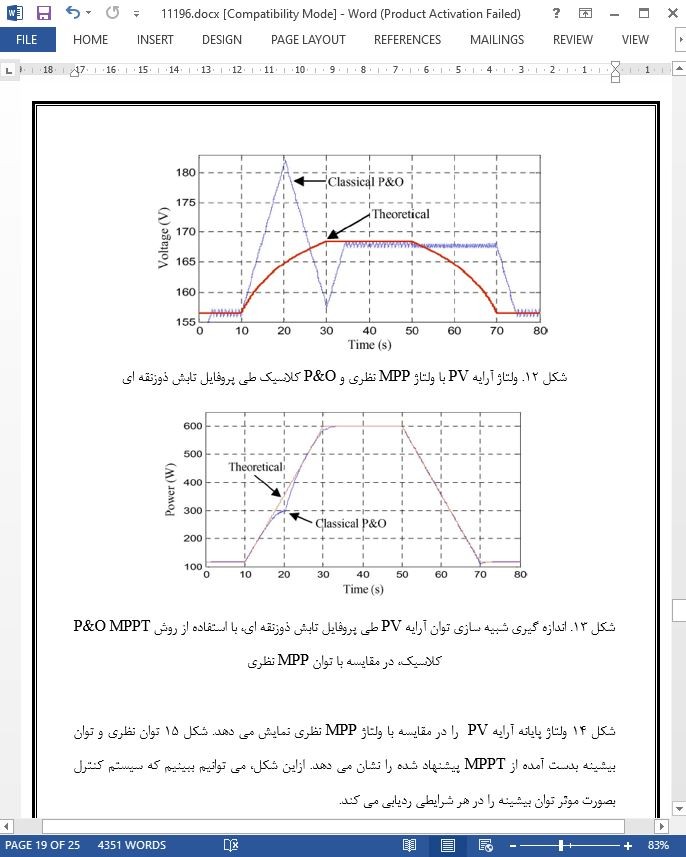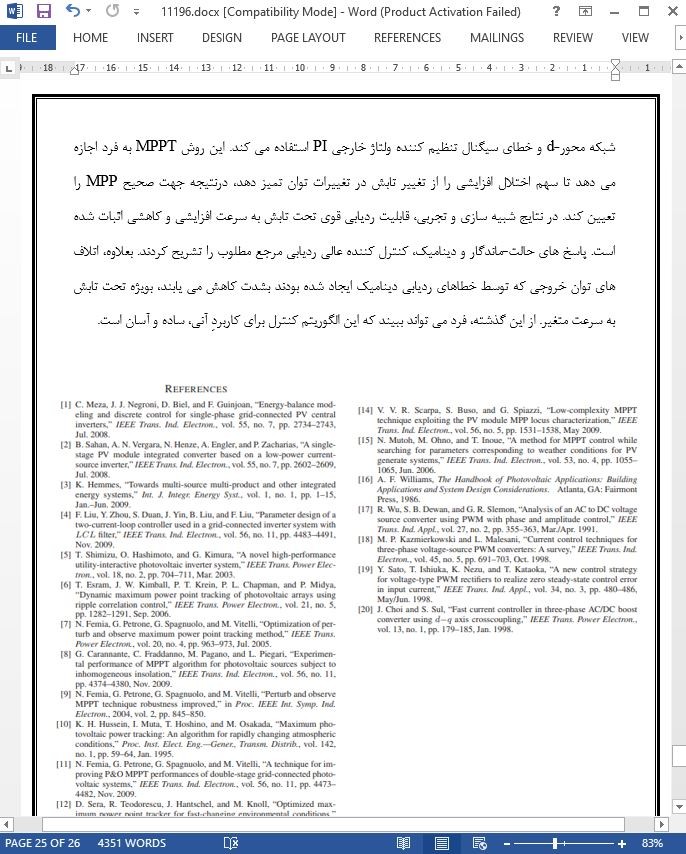
ردیابی بهبود یافته بیشینه منبع توان برای اینورتر فتوولتائیک متصل به شبکه بر اساس کنترل ولتاژگرا
خلاصه
در این مقاله، ردیابی بهبود یافته بیشینه منبع توان (MPP) با عملکرد بهتر بر مبنای کنترل ولتاژگرا (VOC) برای حل مشکل تابش بسرعت متغیر پیشنهاد می شود. در VOC، یک ساختار کنترل متوالی با حلقه کنترل ولتاژ لینک dc خارجی و یک حلقه کنترل جریان داخلی مورد استفاده قرار می گیرد. جریان ها در یک حلقه d,q متعامد سنکرون، با استفاده از کنترل بازخورد مجزا کنترل می شوند. جریان مرجع کنترل کننده محور-d انتگرال متناسب (PI) از تنظیم کننده ولتاژ DC-سمت با اعمال کردن کنترل متوازن کننده انرژی استخراج می شود. بعلاوه، برای بدست آوردن ضریب توان واحد، مرجع محور-q روی صفر تنظیم می شود. کنترل کننده MPPT بر مرجع فتوولتائیک ولتاژ dc (PV) کنترل حلقه خارجی اعمال می شود. بدون اندازه گیری توان آرایه PV، MPPT پیشنهاد شده جهت صحیح MPPT را بوسیله پردازش کردن جریان محور-d تعیین می کند. این جریان، سمت شبکه برق و خطای سیگنال حلقه خارجی PI را که فقط برای ارایه تغییر در توان طراحی شده است بازتاب می دهد. این تغییر توان بدلیل شرایط جوی متغییر می باشد. قابلیت ردیابی قوی تحت تابشِ به سرعت افزایشی و کاهشی با یک مقلد آرایه PV بصورت تجربی تایید می شود. نتایج تجربی و شبیه سازی ها اثبات کردند که روش پیشنهاد شده، ردیابی موثر، سریع و عالی را فرآهم می کند.
I- معرفی
خصوصیت ولتاژ-توان یک آرایه فتوولتائیک (PV) بدلیل تغییرات ایجاد شده توسط شرایط جوی، غیرخطی و متغییر نسبت به زمان است. وظیفه ردیابی بیشینه منبع توان (MMP) در یک سیستم توان PV میزان کردن پیوسته سیستم است بطوری که بیشترین توان را از آرایه PV بگیرد. در سال های اخیر، سیستم های PV متصل به شبکه رایج تر شده اند زیرا نیاز به پشتیبان باتری جهت تضمین MPPT ندارند [1]. دو پیکربندی معمولی سیستم PV متصل به شبکه، تک یا دو مرحله ای هستند. در دو مرحله ای ها، اولی برای تقویت ولتاژ آرایه PV و ردیابی توان بیشینه بکار می رود؛ دومی تبدیل شدن این توان به ولتاژ ac پرکیفیت را مجاز می دارد.
VII. نتیجه گیری
جهت جلوگیری از خطاهای احتمالی الگوریتم P&O کلاسیک بدلیل تابش به سرعت متغیر، این مقاله یک کنترل کننده MPPT بهبود یافته بدون اندازه گیری توان آرایه PV را پیشنهاد کرده است. طرح کنترل ما از مولفه جریان شبکه محور-d و خطای سیگنال تنظیم کننده ولتاژ خارجی PI استفاده می کند. این روش MPPT به فرد اجازه می دهد تا سهم اختلال افزایشی را از تغییر تابش در تغییرات توان تمیز دهد، درنتیجه جهت صحیح MPP را تعیین کند. در نتایج شبیه سازی و تجربی، قابلیت ردیابی قوی تحت تابش به سرعت افزایشی و کاهشی اثبات شده است. پاسخ های حالت-ماندگار و دینامیک، کنترل کننده عالی ردیابی مرجع مطلوب را تشریح کردند. بعلاوه، اتلاف های توان خروجی که توسط خطاهای ردیابی دینامیک ایجاد شده بودند بشدت کاهش می یابند، بویژه تحت تابش به سرعت متغیر. از این گذشته، فرد می تواند ببیند که این الگوریتم کنترل برای کاربردِ آنی، ساده و آسان است.
Abstract
In this paper, an improved maximum power point (MPP) tracking (MPPT) with better performance based on voltage-oriented control (VOC) is proposed to solve a fast-changing irradiation problem. In VOC, a cascaded control structure with an outer dc link voltage control loop and an inner current control loop is used. The currents are controlled in a synchronous orthogonal d , q frame using a decoupled feedback control. The reference current of proportional-integral (PI) d -axis controller is extracted from the dc-side voltage regulator by applying the energy-balancing control. Furthermore, in order to achieve a unity power factor, the q -axis reference is set to zero. The MPPT controller is applied to the reference of the outer loop control dc voltage photovoltaic (PV). Without PV array power measurement, the proposed MPPT identifies the correct direction of the MPP by processing the d -axis current reflecting the power grid side and the signal error of the PI outer loop designed to only represent the change in power due to the changing atmospheric conditions. The robust tracking capability under rapidly increasing and decreasing irradiance is verified experimentally with a PV array emulator. Simulations and experimental results demonstrate that the proposed method provides effective, fast, and perfect tracking.
I. INTRODUCTION
THE VOLTAGE-POWER characteristic of a photovoltaic (PV) array is nonlinear and time varying because of the changes caused by the atmospheric conditions. The task of a maximum power point (MPP) tracking (MPPT) in a PV power system is to continuously tune the system so that it draws maximum power from the PV array. In recent years, the gridconnected PV systems have become more popular because they do not need battery backups to ensure MPPT [1]. The two typical configurations of a grid-connected PV system are single or two stages. In two stages, the first is used to boost the PV array voltage and track the maximum power; the second allows the conversion of this power into high-quality ac voltage.
VII. CONCLUSION
In order to avoid possible mistakes of the classical P&O algorithm due to the fast-changing irradiation, this paper has proposed an improved MPPT controller without PV array power measurement. Our control scheme uses the d-axis grid current component and the signal error of the PI outer voltage regulator. This MPPT method permits one to differentiate the contribution of increment perturbation and irradiation change in power variation, hence identifying the correct direction of the MPP. In the simulation and experimental results, the robust tracking capability under rapidly increasing and decreasing irradiance has been proved. The steady-state and dynamic responses illustrated the perfect desired reference tracking controller. Moreover, the output power losses caused by the dynamic tracking errors are significantly reduced, particularly under fastchanging irradiation. Furthermore, one can see that the control algorithm is simple and easy to implement in real time.
خلاصه
I- معرفی
II- مدلسازی و توصیف سیستم
A. مدل سلول خورشیدی و آرایه PV
B. مدل VSI
III. کنترل کننده های جریان و ولتاژ
A. کنترل جریان
B. کنترل ولتاژ
IV. MPPT پیشنهادشده
A. محاسبه توان PV
B. خطای سیگنال تنظیم کننده ولتاژ خارجی
V. نتایج شبیه سازی
VI. نتایج تجربی
VII. نتیجه گیری
Abstract
I. INTRODUCTION
II. SYSTEM DESCRIPTION AND MODELING
A. Solar Cell and PV Array Model
B. VSI Model
III. CURRENT AND VOLTAGE CONTROLLERS
A. Current Control
B. Voltage Control
IV. PROPOSED MPPT
A. PV Power Calculation
B. Signal Error of Outer Voltage Regulator
V. SIMULATION RESULTS
VI. EXPERIMENTAL RESULTS
VII. CONCLUSION
- ترجمه فارسی مقاله با فرمت ورد (word) با قابلیت ویرایش، بدون آرم سایت ای ترجمه
- ترجمه فارسی مقاله با فرمت pdf، بدون آرم سایت ای ترجمه



